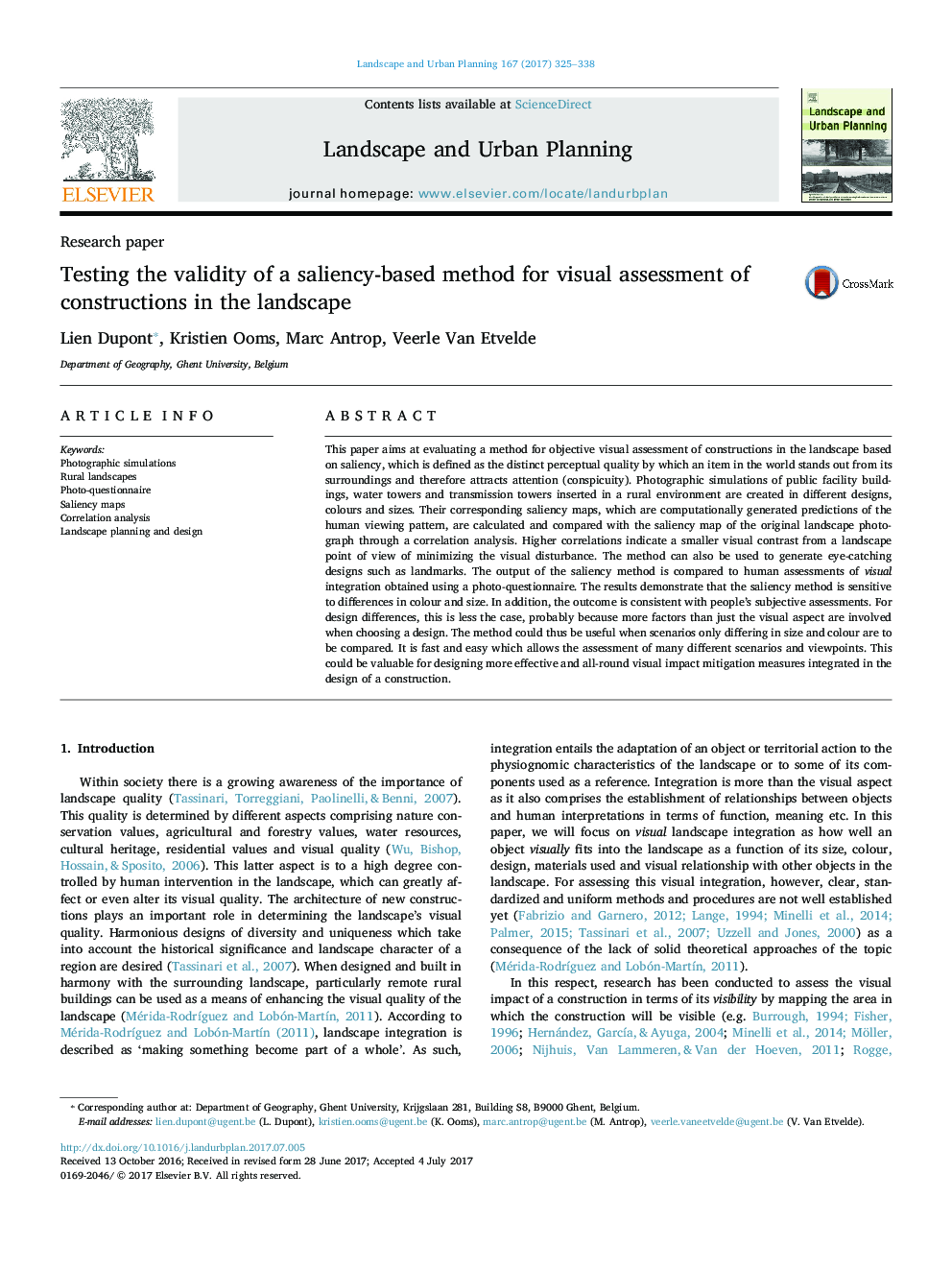| کد مقاله | کد نشریه | سال انتشار | مقاله انگلیسی | نسخه تمام متن |
|---|---|---|---|---|
| 5114963 | 1484591 | 2017 | 14 صفحه PDF | دانلود رایگان |
عنوان انگلیسی مقاله ISI
Testing the validity of a saliency-based method for visual assessment of constructions in the landscape
ترجمه فارسی عنوان
تست روایی یک روش مبتنی بر معیار برای ارزیابی بصری سازه ها در منظر
دانلود مقاله + سفارش ترجمه
دانلود مقاله ISI انگلیسی
رایگان برای ایرانیان
کلمات کلیدی
ترجمه چکیده
این مقاله با هدف ارزیابی یک روش برای ارزیابی بصری عینی از سازه ها در منظر مبتنی بر تمایل، که به عنوان کیفیت ادراکی متمایز تعریف شده است، با توجه به اینکه یک آیتم در جهان از محدوده آن خارج می شود و بنابراین توجه (ظاهر) را جلب می کند. شبیه سازی عکس ها از ساختمان های ساختمان عمومی، برج های آب و برج های انتقال در محیط روستایی در طرح های مختلف، رنگ ها و اندازه ها ایجاد می شود. نقشه های مربوطه مربوط به آن، که پیش بینی های محاسباتی الگوی نمایشی انسان را تولید می کنند، محاسبه می شوند و با نقشه معرفتی عکس اصلی چشم انداز از طریق تحلیل همبستگی مقایسه می شوند. همبستگی بالاتر نشان دهنده کنتراست تصویری کوچکتر از نقطه نظر چشم انداز از کمینه کردن اختلالات بینایی است. این روش همچنین می تواند برای تولید طرح های چشمگیر مانند نشانه ها استفاده شود. خروجی روش شهینسی با ارزیابی انسانی ادغام بصری با استفاده از یک عکس-پرسشنامه مقایسه شده است. نتایج نشان می دهد که روش کشش حساس به تفاوت های رنگ و اندازه است. علاوه بر این، نتیجه با ارزیابی ذهنی افراد سازگار است. برای تفاوت های طراحی، این مورد کمتر است، احتمالا به این دلیل که هنگام انتخاب طراحی بیشتر عوامل بیش از جنبه بصری درگیر است. بنابراین روش می تواند مفید باشد، در صورتی که سناریوها فقط با اندازه و رنگ متفاوت با یکدیگر متفاوت باشند. این سریع و آسان است که اجازه می دهد تا ارزیابی بسیاری از سناریوها و دیدگاه های مختلف. این امر می تواند برای طراحی موثرتر و همه جانبه اقدامات کاهش آسیب دید بصری یکپارچه در طراحی یک ساخت و ساز مفید باشد.
موضوعات مرتبط
علوم زیستی و بیوفناوری
علوم کشاورزی و بیولوژیک
بوم شناسی، تکامل، رفتار و سامانه شناسی
چکیده انگلیسی
This paper aims at evaluating a method for objective visual assessment of constructions in the landscape based on saliency, which is defined as the distinct perceptual quality by which an item in the world stands out from its surroundings and therefore attracts attention (conspicuity). Photographic simulations of public facility buildings, water towers and transmission towers inserted in a rural environment are created in different designs, colours and sizes. Their corresponding saliency maps, which are computationally generated predictions of the human viewing pattern, are calculated and compared with the saliency map of the original landscape photograph through a correlation analysis. Higher correlations indicate a smaller visual contrast from a landscape point of view of minimizing the visual disturbance. The method can also be used to generate eye-catching designs such as landmarks. The output of the saliency method is compared to human assessments of visual integration obtained using a photo-questionnaire. The results demonstrate that the saliency method is sensitive to differences in colour and size. In addition, the outcome is consistent with people's subjective assessments. For design differences, this is less the case, probably because more factors than just the visual aspect are involved when choosing a design. The method could thus be useful when scenarios only differing in size and colour are to be compared. It is fast and easy which allows the assessment of many different scenarios and viewpoints. This could be valuable for designing more effective and all-round visual impact mitigation measures integrated in the design of a construction.
ناشر
Database: Elsevier - ScienceDirect (ساینس دایرکت)
Journal: Landscape and Urban Planning - Volume 167, November 2017, Pages 325-338
Journal: Landscape and Urban Planning - Volume 167, November 2017, Pages 325-338
نویسندگان
Lien Dupont, Kristien Ooms, Marc Antrop, Veerle Van Etvelde,
